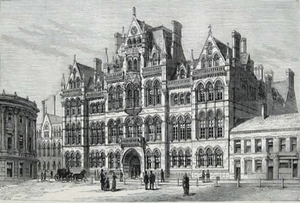Adrian John Brown facts for kids
Quick facts for kids
Adrian John Brown
|
|
|---|---|
| Born | 27 April 1852 Burton-on-Trent, Staffordshire, England
|
| Died | 2 July 1919 (aged 67) |
| Education | Royal College of Science, London |
| Scientific career | |
| Fields | Malting and brewing, fermentation, enzyme action |
| Institutions | Burton-on-Trent, St Bartholomew's Hospital, London, University of Birmingham |
Adrian John Brown (born April 27, 1852 – died July 2, 1919) was a British scientist. He became a professor at the University of Birmingham. He was very important in studying how tiny helpers called enzymes work.
Early Life and Education
Adrian John Brown was born in Burton-on-Trent, England. His father, Edwin Brown, was a bank manager. Adrian went to the local grammar school. After that, he studied chemistry at the Royal College of Science in London.
He worked as an assistant to Dr. Russell at St Bartholomew's Hospital Medical School. In 1873, he went back to his hometown. He worked as a chemist in the brewing industry for 25 years. Brewing is the process of making drinks like beer.
In 1899, Adrian Brown became a professor. He taught about brewing and malting at Mason University College. This college later became the University of Birmingham in 1900.
Discoveries About Enzymes
Professor Brown studied how fermentation happens. Fermentation is a chemical change caused by tiny living things like yeast. He looked at how fast yeast changed sucrose (a type of sugar).
In 1892, he suggested something new. He thought that a special substance inside yeast was speeding up the reaction. This was a big idea! It was the first time scientists thought of enzymes as separate chemicals. Before this, people thought only living organisms could cause these changes.
How Enzymes Work
Adrian Brown continued to study these special substances, which we now call enzymes. He made an important suggestion. He believed that enzymes and the substances they work on (called substrates) temporarily join together. This forms an "enzyme-substrate complex."
Imagine a key fitting into a lock. The enzyme is like the key, and the substrate is like the lock. They fit together perfectly to make something happen. This idea became the basic rule for understanding how enzymes work. Another scientist, Hermann Emil Fischer, also used the key-and-lock idea to explain this process.
Adrian John Brown's work helped us understand how enzymes help our bodies and many other living things.


